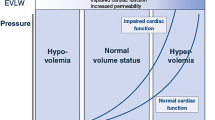Summary
The haemodynamic effects of halothane-N2O/O2 anaesthesia with controlled ventilation were studied in rats, using the microsphere method. Mean arterial blood pressure was significantly reduced but only minor effects on cardiac output (CO), heart rate, and systemic vascular resistance were seen. During anaesthesia, there were significantly increased fractions of CO delivered to brain, lungs, small intestine and liver (hepatic artery), while the fractions to spleen, stomach and carcass were decreased. Fractional distribution and regional blood flow to heart, kidneys, adrenals and preportal area remained unchanged. When anaesthesia was prolonged from 60 to 90 min, no further changes in central or regional haemodynamics were seen.
Considering the minor effects on central haemodynamics and the abscense of changes in central and regional haemodynamics at 60 and 90 min, this anaesthesia model should be useful in experimental research.
Similar content being viewed by others
References
Ahlgren I, Aronsen KF, Björkman I, Wetterlin S (1978) The haemodynamic effects of halothane in the normovolemic dog. Acta Anaesthesiol Scand 22:83–92
Andréen M, Irestedt L, Zetterström B (1977) The different responses of the hepatic arterial bed to hypovolemia and to halothane anaesthesia. Acta Anaesthesiol Scand 21:457–469
Archie J, Fixler D, Ullyot D, Hoffman J, Utley J, Carlsson E (1973) Measurement of cardiac output with and organ trapping of microspheres. J Appl Physiol 35:148–154
Bahlman SH, Eger EJ, Smith NT, Stevens WC, Shakespeare TF, Sawyer DC, Halsey MJ, Cromwell TH (1971) The cardiovascular effects of nitrous oxide-halothane anaesthesia in man. Anesthesiology 35:274–285
Bergman G, Husberg B (1980) A method for multiple intraarteriel injections in the allogenic or isogenic transplanted rat kidney by use of a long term catheter in the renal artery. Scand J Urol Nephrol [Suppl] 54:116–119
Duncan WAM, Raventos J (1959) The pharmacokinetics of halothane (fluothane) anaesthesia. Br J Anaesth 31:302–315
Eger EI, Smith NT, Stoelting RK, Cullen DJ, Kadis LB, Witcher CE (1970) Cardiovascular effects of halothane in man. Anesthesiology 32:396–407
Engqvist A, Brandt MR, Fernandes A, Kehlet A (1977) The blocking effect of epidural analgesia on the adreno-cortical and hyperglycemic responses to surgery. Acta Anaesthesiol Scand 21:330–335
Idvall J, Aronsen KF, Nilsson L, Nosslin B (1979) Evaluation of the microsphere method for determination of cardiac output and flow distribution in the rat. Eur Surg Res 11:423–433
Kaihara S, Rutherford R, Schwenker E, Wagner HN, Jr (1969) Distribution of cardiac output in experimental hemorrhagic shock in dogs. J Appl Physiol 27:218–222
Lees MH, Hill J, Ochsner AJ, Thomas C(1971) Regional blood flows of the rhesus monkey during halothane anaesthesia. Anesth Analg 50:270–281
Loarie DJ, Wilkinson P, Tyberg J, White A (1979) The haemodynamic effects of halothane in anemic dogs. Anesth Analg 58:195–200
Miller ED, Kistner JR, Epstein RM (1980) Whole-body distribution of radioactively labelled microspheres in the rat during anaesthesia with halothane, enflurane or ketamine. Anesthesiology 52:296–302
Prys-Roberts C (1980) The circulation in anaesthesia. Applied physiology and pharmacology. Blackwell, Oxford
Raventos J (1956) The action of fluothane, a new volatile anesthetic. Br J Pharmacol 11:394–410
Ross WT Jr, Daggy BP (1981) Hepatic blood flow in phenobarbital-pretreated rats during halothane anaesthesia and hypoxia. Anesth Analg 60:306–309
Rudolph AM, Heymann MA (1967) The cirulation of the fetus in utero. Methods for studying distribution of blood flow, cardiac output and organ blood flow. Circ Res 21:163–184
Sasaki Y, Wagner HN, Jr (1971) Measurements of distribution of cardiac output in unanaesthetized rats. J Appl Physiol 30:879–884
Severinghaus JW, Cullen SC (1958) Depression of myocardium and body oxygen consumption with Fluothane in man. Anesthesiology 19:165–177
Smith NT, Eger EI, Stoelting RK, Whayne TF, Cullen D, Kadis LB (1970) The cardiovascular and sympathomimetic responses to the addition of nitrous oxide to halothane in man. Anesthesiology 32:410–421
Smith AL (1973) The mechanism of cerebral vasodilation by halothane. Anesthesiology 39:581–587
Svedman P (1979) Cardiac output distribution in animals measured with radioactive dextran micropheres. Doctoral thesis, Malmö
Author information
Authors and Affiliations
Rights and permissions
About this article
Cite this article
Gustafson, C., Aronsen, K.F., Idvall, J. et al. Central haemodynamics and regional blood flow during halothane-nitrous oxide anaesthesia and controlled ventilation. Res. Exp. Med. 182, 193–201 (1983). https://doi.org/10.1007/BF01851708
Received:
Accepted:
Issue Date:
DOI: https://doi.org/10.1007/BF01851708




